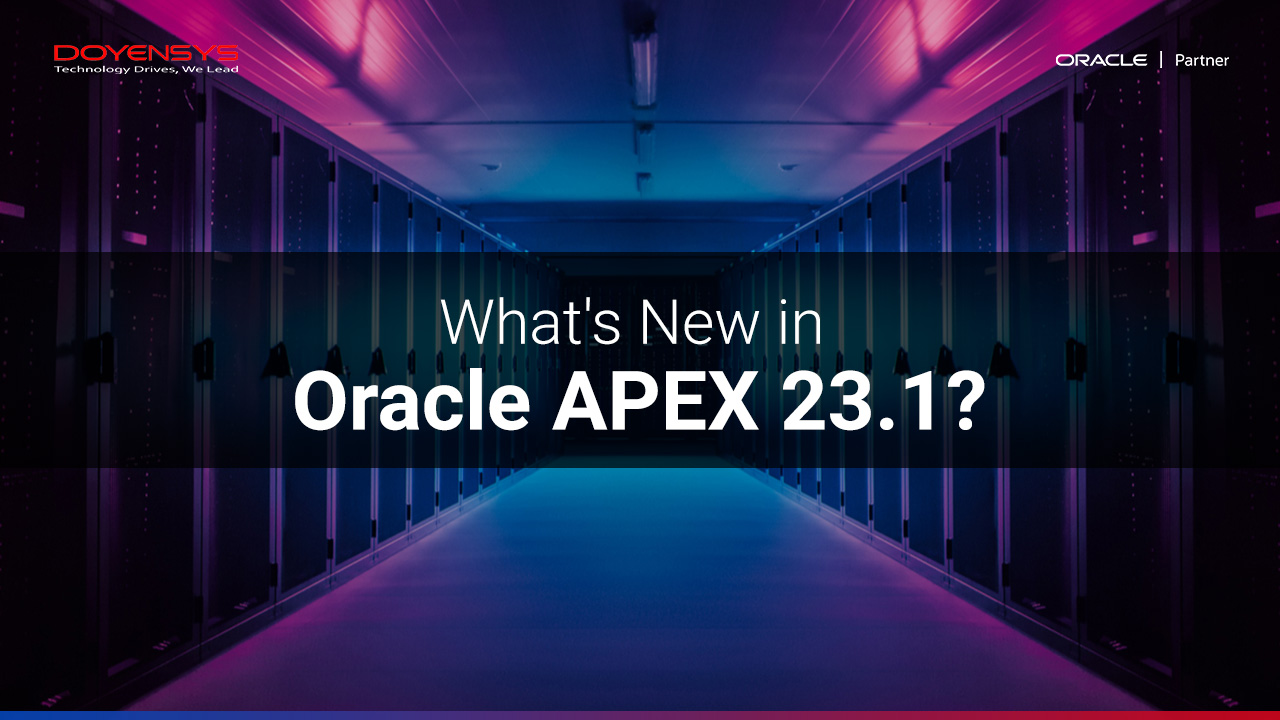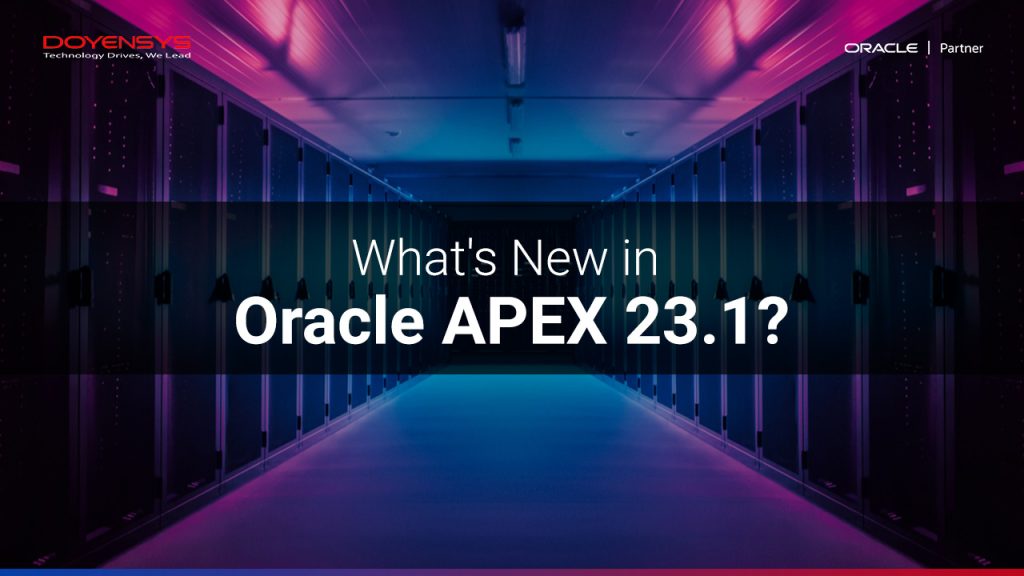
OCI (Oracle Cloud Infrastructure) areas worldwide have rolled out Oracle APEX 23.1 version, which is generally accessible for download. It means all newly created Autonomous Databases and APEX Service instances will come with APEX 23.1 when it becomes available in a cloud area. Existing customers of these services can update to APEX 23.1 by making an API request or button click.
The world’s most well-known low-code application platform, Oracle APEX, allows you to create scalable, secure corporate apps with cutting-edge capabilities deployed anywhere, whether on-premises or in the public cloud/private cloud.
In addition to being a free feature with any Oracle Database subscription, including Autonomous Database, Oracle APEX is a standalone, fully managed service in Oracle Cloud Infrastructure (OCI).
This release includes several new and updated components, major improvements to the developer experience, PWA push notifications, a modernized object browser, REST data source & page enhancements.
But before we explore a few of Oracle APEX 23.1‘s standout features, let’s first know why Oracle Apex is popular.
 Why Oracle APEX?
Why Oracle APEX?
Oracle APEX was built from the bottom up to let developers construct cutting-edge, attractive, responsive apps without becoming subject-matter experts. Oracle APEX promises to make it possible for developers to easily build compelling apps with excellent performance, functionality, and user interface.
Oracle APEX strives to reduce the complexity of creating and delivering corporate apps to accomplish this purpose.
What’s more?
1. Easy to Get Started
You only need to set up a simple software on your PC., other than a web browser, before you can start using Oracle APEX. There is no need for extra tools; web browsers may be used for any application development.
2. Low-code Platform
Oracle Application Express (APEX) includes nearly all the standard and essential functionality for application development. Without writing any code, one can develop fantastic apps with its user-friendly interface that allows you to “drag and drop” potent low-code components like Charts, Interactive Grids, and Faceted Search—productivity increases since there is less code to write and less chance of error.
3. Portable
As long as the Oracle Database runs, developers may create & deploy Oracle APEX applications on-premises, in a private cloud like the Syntax Enterprise Cloud, or on a public cloud like OCI—application migration between on-premises & cloud-hosted environments like Oracle APEX.
4. Integrated with Oracle Database
The Oracle APEX engine is safe, scalable, and stable since it is housed in the Oracle Database. The Oracle Database capability allows for implementing high availability features like failover and redundancy. Furthermore, Database Vault and other built-in Advanced security capabilities of the Oracle Database may be accessed via Oracle APEX.
5. Cost of Ownership
Your license for the Oracle Database server comes with Oracle Application Express (APEX). Oracle APEX is free if you already have an Oracle Database server license. Additionally, Oracle APEX-based apps do not need a middle-tier or application server, such as Oracle WebLogic Server, which typically raises the cost of license and infrastructure.
9 new features in Oracle APEX 23.1:
So, we have learned what Oracle APEX stands for. Now, let’s know what the new Oracle APEX rollout brings.
1. Template Components
First, there are the Template Components, a new plug-in category for creating repeatable UI components in Page Designer that support actions, menus, and custom properties. These elements can be used both as independent regions presenting one or more rows of data and as partials for columns in reports.
You can build plug-ins with properties that can be configured declaratively in Page Designer using Template Components. Additionally, you can customize Actions and Menu buttons for Template Components with row-level constraints thanks to the addition of Action Positions and Action Templates for plug-ins.
2. PWA Push Notifications
Next are push notifications with low code that can be enabled with a simple switch. You can notify users of desktop and mobile devices who have chosen to receive push notifications easily.
While instance managers have a queue of messages, APEX users can subscribe to push notifications from within their apps. Also, push notification transmission from APEX apps now utilizes a new native procedure and open API.
3. Modernized Object Browser
Managing database objects is now simpler than ever with the new Object Browser, which offers a more open and simplified user experience. Now, all sorts of database items can be seen and filtered from a single tree. An improved editing experience makes it simple to edit the last object you were viewing, and a new maritime warning guarantees that mistakenly lost changes are never lost.
4. Page Processing Improvements
Now, arrange a series of page processes to transfer work to the background or make conditional execution easier to maintain. The addition of monitoring to the Active Sessions tab gives users better control over background operations.
5. REST Data Source Enhancements
REST Data Sources have been modified to give users more flexibility over source discovery and replies. Support for Simple HTTP Rest Data Source using Open API/Swagger is included in this edition. You can create a full REST Data Source based on a response that includes the data profile and any extra metadata, such as actions, URLs, or other parameters.
6. Improvements to APEX Administration
With daily metrics and trend charts, now made available daily in the new APEX Administrator Digest, you can monitor the condition of your instances, workspaces, and schemas. With an updated UI and API that lets you establish and manage a block list of email patterns, creating workspaces in an instant became simpler.
7. Universal Theme and UX Improvements
Updates to Universal Theme include new internal Template Components, a better Region Display Selector, faster page rendering, and more. The new Actions menu button on the Theme Roller interface simplifies downloading and submitting themes.
8. Approvals Component Enhancements
Due dates can be added when establishing approval tasks in the Approvals component. The Human Task – Create process plugin now supports the Due Date item as a property. This value will precede the underlying task definition’s due date parameters when supplied.
Additionally, a due date parameter has been added to the Task API. This value will precede the underlying task definition’s due date parameters when specified.
9. SQL Developer Web Integration
You can access SQL Developer Web from the menu bar’s SQL Workshop option. It is supported on ORDS version 23.1; instance-level configuration is required. SQL Developer Web will launch in a different tab for workspaces with a single REST-enabled DB schema.
If not, a modal popup with a list of the schemas will appear, asking developers if they want to connect to them or make them REST-enabled.
In conclusion:
Oracle APEX offers a tried-and-true platform for scalable enterprise applications in a corporate environment. The REST and SOAP services in your company and the cloud can be integrated with Oracle APEX using native capability.
Additionally, Oracle APEX offers a visual user interface (GUI) for developing and hosting secure REST services that connect to database data and business logic. With this update, Oracle APEX brings several new features and addresses countless bugs, improving the quality and stability of APEX environments.
Want to get hands-on experience with Oracle APEX 23.1? Doyensys can help. We are a provider of cutting-edge Oracle platform solutions in the IT sector, with the major success metric being a laser focus on customer satisfaction. Let us help you with the Oracle APEX journey.
